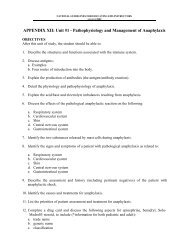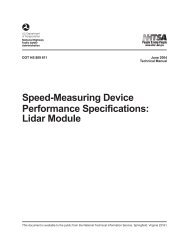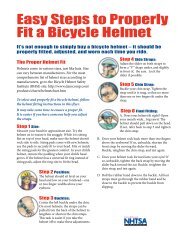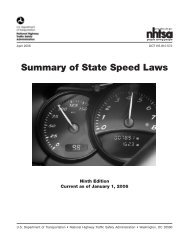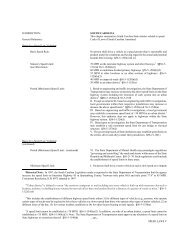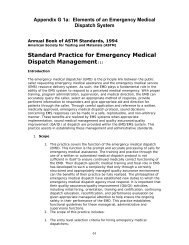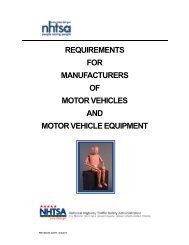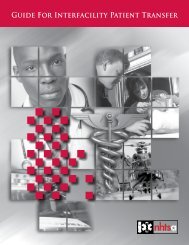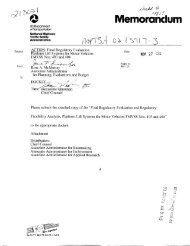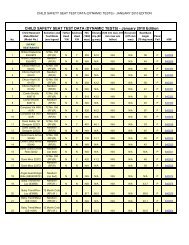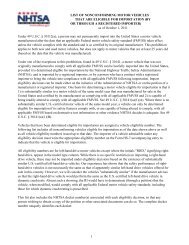The Criminal Justice System: A Guide for Law Enforcement ... - NHTSA
The Criminal Justice System: A Guide for Law Enforcement ... - NHTSA
The Criminal Justice System: A Guide for Law Enforcement ... - NHTSA
You also want an ePaper? Increase the reach of your titles
YUMPU automatically turns print PDFs into web optimized ePapers that Google loves.
4. You are not required to know anything about the Intoxilyzer 5000 or your<br />
jurisdiction’s breath test instrument, its internal workings, or anything other than how<br />
to operate it and take a breath sample from a defendant. You are merely an operator<br />
of an instrument, and while you have been taught something about how the<br />
instrument works when you became certified as an operator, never testify to its<br />
internal workings, or the defense attorney will discredit you as someone who “thinks<br />
he knows it all.” You know your cell phone works when you make and receive calls<br />
and could testify to its proper operation without knowing how it does what it does.<br />
NOTE: DO NOT bring the breathalyzer operator’s manual to court, or the<br />
log, unless instructed to by the prosecutor. Discuss any subpoena to<br />
produce with the prosecutor be<strong>for</strong>e complying with the subpoena.<br />
5. YOU MUST BE ABLE TO EXPLAIN AT TRIAL “INVALID SAMPLE” AND<br />
THE NEED FOR A SUBSEQUENT TEST. If you get an “Invalid Sample” the<br />
instrument has either detected residual mouth alcohol or the defendant has failed to<br />
give an adequate deep-lung air sample. You must restart the 15- or 20-minute waiting<br />
period and repeat the test, or, if allowed in your jurisdiction, take the subject <strong>for</strong> a<br />
blood test. Remember to write the blood drawer’s name and title (doctor, nurse, etc.)<br />
on the police report. It is also a “best practice” to witness the blood draw yourself –<br />
this may allow the prosecutor to avoid having to call other hospital personnel as a<br />
witness. FOLLOW ALL PROCEDURES FOR COLLECTION AND CHAIN OF<br />
CUSTODY OF THE BLOOD KIT.<br />
6. When testifying about field sobriety evaluations, remember to discuss the level of<br />
impairment of the defendant, not just the “numbers” or the conclusion that he<br />
“passed” or “failed.” Generally, officers can testify to numerical scores on field<br />
sobriety tests, including Horizontal Gaze Nystagmus (HGN), and can testify to the<br />
level of impairment. Describe each of the tests you asked the defendant to per<strong>for</strong>m<br />
and how he did, step by step. For example, on the Walk and Turn, you might testify,<br />
after describing the test, that the defendant put out his arms <strong>for</strong> balance, did not count<br />
properly by counting “one, two, four, four, five,” and when putting one foot in front<br />
of the other, he failed seven out of nine times to touch heel-to-toe and then gave up<br />
doing the test. In many jurisdictions, based upon your specialized training and<br />
experience, you could say, after describing in detail the steps involved in the HGN<br />
test: “the defendant scored six out of a possible six clues on the HGN, and four clues<br />
is considered impaired.” Thus, you would offer your opinion that he failed the tests<br />
and was intoxicated. However, see number 8 below.<br />
7. If you are IACP/<strong>NHTSA</strong>-trained and testify as to the accuracy of the field sobriety<br />
tests, it is best practice to stay away from discussing the numbers and their<br />
significance! <strong>The</strong> numbers referenced in the various studies commissioned by<br />
<strong>NHTSA</strong> are wide open <strong>for</strong> misinterpretation. Follow the dictates below.<br />
14



